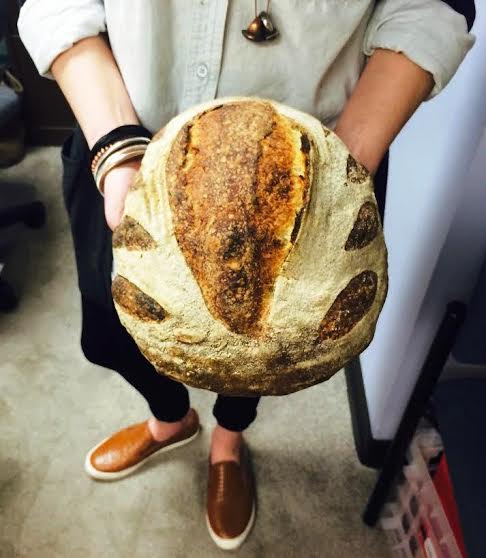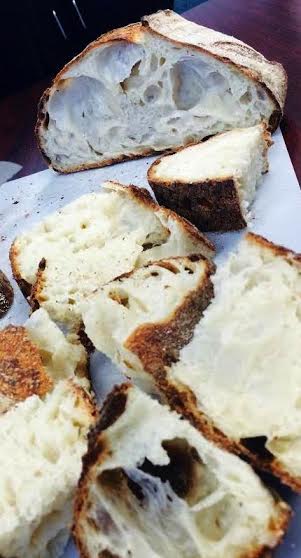
I'm still on this 5% levain, 80% hydration kick! Both of these loaves built on the formula I referred to in my previous post.
The first was inspired by Dave's recent rosemary and black olive loaf. I just added a tablespoon of fresh rosemary, 60 g black olives, and 60 g green olives:



And then the formula, with the addition of 100 g of old dough, which reduced the fermentation time by about 2 hours, and made the loaf many times more fragrant (pate fermentee is amazing, even in small amounts):



Maybe not the ideal crumb for sandwiches...but pretty good with olive oil and cracked pepper!
--Hannah
- a_warming_trend's Blog
- Log in or register to post comments
I was cheekily going to ask where the butter/sammich fillings would go, but it looks amazing, and I bet dipped in good olive oil (or tapenade, or hummus, or pesto) would be amazing.
You are the queen of creative scoring! How did you get the teardrop shape?! Is it the progressively smaller cuts on the sides?
-Gabe
I think that the angle of the photo might make it look a little more teardrop-ish than it actually was; I basically did one middle slash and then four very shallow angled slashes along the side. I'm still working on really pulling the primary slash fully from end-to-end to maximize the ear!
... the crumb is getting even more open than before. What beauties! O.k., let me understand: you are adding 100g of pâte fermentée to your dough. Can you describe the process? Is your pâte fermentée truly 100g of saved dough from a previous bread and contains thus salt? And if yes, is it an old dough made with only levain? Or does it contain regular yeast? And one more question: if it is from a previous dough, did you save 100g, or did you keep less and then built the lesser amount up to a 100g?
Merci beaucoup!
Old dough is the best, so I hope I answer your questions well:
1) Yes, absolutely. When I know I want to use pate fermentee in a loaf coming up, I reserve whatever amount I want to use in the new loaf from a fully fermented dough, just before shaping that loaf. So yes, there is salt in it. Because of that, I add the old dough to the flour + water mixture of the new dough after the autolyse, just as I would add levain.
2) No commercial yeast--it's literally just a chunk of dough from a not-yet-baked sourdough loaf. And of course, it's always a relatively simple loaf from which I reserve dough--could be any combination of grains, but never any added flavors or mix-ins. In my short time baking with old dough, my general rule is: Double the amount of pate fermentee by weight to the amount of levain you would use in a loaf, and it will ferment in about the same amount of time. So, if I want to ferment a loaf purely with old dough, I would use 300 grams of old dough in place of 150 grams of levain. Sometimes I ferment a whole loaf with just old dough--sometimes I use a mixture of levain and old dough. Always, always, old dough improves the flavor (and, I really think, the texture as well).
3) If I'm thinking far enough ahead, I increase the size of the loaf from which I want to reserve dough. Sometimes I'm not forward-thinking enough for that...so I just reserve the amount I want to use in the next loaf, and settle for a smaller loaf from the current dough.
I love the idea that in theory, you could make the same loaf of bread forever without ever using new starter/levain or commercial yeast. You could always just make enough dough to reserve the pate fermentee for the next loaf. On and on, infinitely. That's cool.
for taking the time to elaborate on your process. Makes total sense. I have never used old dough but will definitely start doing this, your results are too convincing!
even for commercial yeast ciabatta. I would have it with some balsamic mixed with: olive oil, fresh rosemary and basil, cracked black pepper, pecorino and parm please...or toasted on the grill with any kind of bruschetta on top. Well done and happy baking.
Really enjoying your posts and your experiments. They all look great and I get the sense you are starting to really get some great ideas and concepts from it all that are guiding you to the next loaf! Bravo
That is just about the most perfectly custard-y crumb I have seen. Congrats on your 80% hydration success. Something I would love to use as a new standard.
Happy baking and thanks for the post.
John
for the lovely comment! 80% seems to be my sweet spot for manageability/ovenspring balanced with openness of crumb. Many more experiments to come!
I'm not sure if you're still active on this group, but I would appreciate some advice.
I wouldo like to make some bread with only old dough as you have done here. Does the old dough need to be in a certain state development/ activity? Or can it be in any state, as long as it's relatively fresh. How long do you feel comfortable keeping it in the fridge? Do you ever freeze your old dough to be used at a later date?
Thank you in advance for your reply.
~A